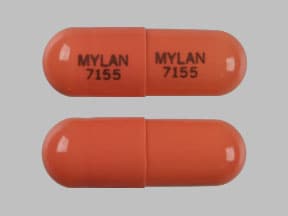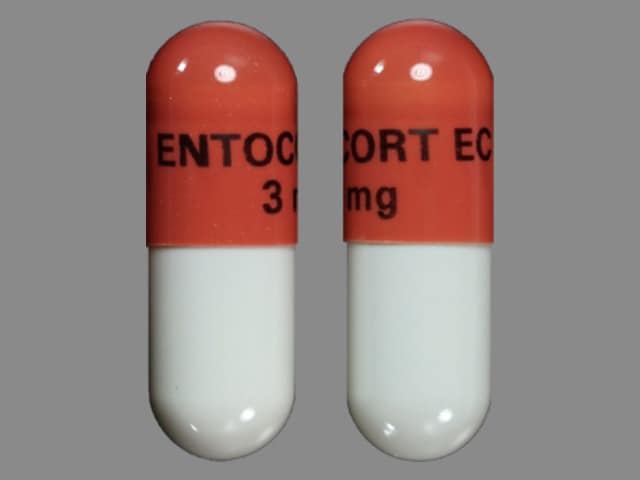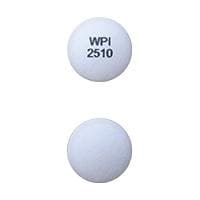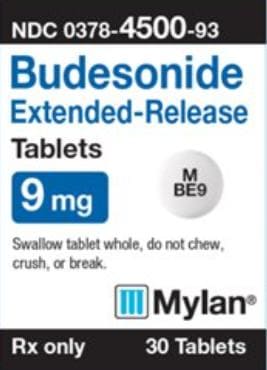Dosage Forms
Excipient information presented when available (limited, particularly for generics); consult specific product labeling.
Foam, Rectal:
Uceris: 2 mg/actuation (33.4 g) [contains cetyl alcohol, edetate disodium, propylene glycol]
Pharmacology
Mechanism of Action
Controls the rate of protein synthesis; depresses the migration of polymorphonuclear leukocytes, fibroblasts; reverses capillary permeability and lysosomal stabilization at the cellular level to prevent or control inflammation. Has potent glucocorticoid activity and weak mineralocorticoid activity.
Pharmacokinetics/Pharmacodynamics
Absorption
Rectal foam: Minimal; Rectal enema [Canadian product]: Rapid and essentially complete within 3 hours
Distribution
Vd: 2.2 to 3.9 L/kg
Metabolism
Extensive hepatic metabolism, primarily by CYP3A4 to 2 major metabolites (negligible glucocorticoid activity)
Excretion
Urine: Oral dose: ~60%; Feces: ~30%
Time to Peak
Rectal enema [Canadian product]: 1.5 hours
Half-Life Elimination
Rectal enema [Canadian product]: 2 to 3 hours
Protein Binding
85% to 90%
Use: Labeled Indications
Ulcerative colitis: Remission induction in patients with active mild to moderate distal ulcerative colitis extending up to 40 cm from the anal verge
Entocort Enema [Canadian product]: Management of distal ulcerative colitis (rectum, sigmoid, and descending colon)
Contraindications
Hypersensitivity to budesonide or any component of the formulation
Entocort enema [Canadian product]: Known hypersensitivity to budesonide or any component of the formulation; imminent bowel perforation as well as the probability of obstruction, abscess or other pyogenic infection, fresh intestinal anastomoses, extensive fistulas and sinus tracts; systemic or local bacterial, fungal, or viral infections; active tuberculosis
Dosage and Administration
Dosing: Adult
Ulcerative colitis:
Rectal foam:
Initial: 2 mg (one metered dose) twice daily for 2 weeks.
Maintenance: 2 mg (one metered dose) once daily for 4 weeks.
Rectal enema [Canadian product]: Initial: ~2 mg (one enema) once daily at night prior to bedtime for 4 weeks; if remission is not induced may continue for additional 4 weeks (total therapy duration: 8 weeks)
Dosing: Geriatric
Refer to adult dosing.
Reconstitution
Enema [Canadian product]: Remove nozzle and protective cap from enema bottle; place one dispersible tablet into enema bottle. Place nozzle back on the bottle, ensure protective cap is secured, then shake bottle vigorously for at least 10 seconds or until tablet is completely dissolved (suspension should turn slightly yellowish). Volume of reconstituted enema is 115 mL.
Administration
Rectal: Rectal foam: For rectal use only; not for oral use. Wash hands before and after use. Prior to use, patients should use the bathroom to empty the bowel. Attach applicator to canister nozzle. Each applicator is coated with a lubricant. If additional lubrication is needed, petrolatum or petroleum jelly can also be used. Warm the canister in the hands while shaking it vigorously for 10 to 15 seconds prior to use. Unlock the canister by twisting the domed canister top until it is aligned with the nozzle. May be used in a standing, lying or sitting position (eg, while sitting on the toilet). Turn the canister upside down and gently insert applicator tip into rectum as far as is comfortable. Push down on the pump dome with forefinger and hold for 2 seconds; release finger pressure on pump dome and hold applicator in place for 10 to 15 seconds. Only use applicator provided by manufacturer; do not insert any part of the aerosol container in the rectum. After administering, withdraw and discard the used applicator in provided plastic trash bag. Evening doses should be applied immediately prior to bedtime. Patient should try not to empty the bowel again until the next morning. Avoid fire, flame and smoking during and immediately following administration. Temporarily discontinue use before initiation of bowel preparation for colonoscopy; consult provider prior to resuming therapy.
Rectal enema [Canadian product]: For rectal use only; not for oral use. Patient should lie down on left side, shake the reconstituted enema bottle, remove protective cap and then empty contents into rectum. Patient should roll over on stomach and remain in this position for 5 minutes, then lie in a comfortable position. Enema should be retained the whole night if possible or as long as possible.
Dietary Considerations
Avoid consumption of grapefruit or grapefruit juice during treatment
Storage
Store at 20°C to 25°C (68°F to 77°F); excursions permitted to 15°C to 30°C (59°F to 86°F). Do not expose to heat or store at temperatures above 49°C (120°F). Do not refrigerate.
Enema [Canadian product]: Store at 15°C to 30°C (59°F to 86°F). Use immediately after preparation.
Budesonide (Topical) Images
Drug Interactions
Aldesleukin: Corticosteroids may diminish the antineoplastic effect of Aldesleukin. Avoid combination
Corticorelin: Corticosteroids may diminish the therapeutic effect of Corticorelin. Specifically, the plasma ACTH response to corticorelin may be blunted by recent or current corticosteroid therapy. Monitor therapy
CYP3A4 Inhibitors (Moderate): May increase the serum concentration of Budesonide (Topical). Management: Per US prescribing information, avoid this combination. Canadian product labeling does not recommend strict avoidance. If combined, monitor for excessive glucocorticoid effects as budesonide exposure may be increased. Consider therapy modification
CYP3A4 Inhibitors (Strong): May increase the serum concentration of Budesonide (Topical). Management: Per US prescribing information, avoid this combination. Canadian product labeling does not recommend strict avoidance. If combined, monitor for excessive glucocorticoid effects as budesonide exposure may be increased. Consider therapy modification
Deferasirox: Corticosteroids may enhance the adverse/toxic effect of Deferasirox. Specifically, the risk for GI ulceration/irritation or GI bleeding may be increased. Monitor therapy
Grapefruit Juice: May increase the serum concentration of Budesonide (Topical). Avoid combination
Hyaluronidase: Corticosteroids may diminish the therapeutic effect of Hyaluronidase. Management: Patients receiving corticosteroids (particularly at larger doses) may not experience the desired clinical response to standard doses of hyaluronidase. Larger doses of hyaluronidase may be required. Consider therapy modification
Ritodrine: Corticosteroids may enhance the adverse/toxic effect of Ritodrine. Monitor therapy
Adverse Reactions
Frequency not always defined.
>10%: Endocrine & metabolic: Decreased plasma cortisol (17%)
1% to 10%:
Endocrine & metabolic: Adrenocortical insufficiency (4%), hpa-axis suppression, hypercortisolism
Gastrointestinal: Nausea (2%)
<1%, postmarketing, and/or case reports: Acne vulgaris, adrenal cortex hypofunction, agitation, allergic dermatitis, anaphylaxis, anxiety, depression, diarrhea, dizziness, drowsiness, dysphoria, emotional lability, exacerbation of diabetes mellitus, fever, flatulence, hyperacidity (peptic ulcer), hyperglycemia, hypertension, insomnia, maculopapular rash, pancreatitis, peripheral edema, pruritus, pseudotumor cerebri, skin rash, sleep disorder, urticaria
Warnings/Precautions
Concerns related to adverse effects:
- Adrenal suppression: May cause hypercortisolism or suppression of hypothalamic-pituitary-adrenal (HPA) axis, particularly in patients receiving high doses for prolonged periods, or with concomitant CYP3A4 inhibitor use. HPA axis suppression may lead to adrenal crisis. Withdrawal and discontinuation of a corticosteroid should be done slowly and carefully. In situations where patients are subject to surgery or other stress situations, supplementation with systemic glucocorticoids is recommended.
- Impaired adrenal suppression in patients transferred from other glucocorticoids: Monitor patients transferred from systemic corticosteroids to corticosteroids with lower systemic effects (eg rectal foam), since steroid withdrawal, including benign intracranial hypertension or acute adrenal suppression, may occur. Replacement of systemic corticosteroids with rectal foam may unmask allergies (eg, rhinitis and eczema) previously controlled by systemic drug. Adrenocortical function monitoring may be required in these patients; reduce dose cautiously.
- Immunosuppression: Prolonged use of corticosteroids may also increase the incidence of secondary infection, mask acute infection (including fungal infections), prolong or exacerbate viral infections, or limit response to vaccines. Exposure to chickenpox should be avoided; if exposed, therapy with varicella zoster immune globulin (VZIG) or pooled intravenous immunoglobulin (IVIG) may be needed; antivirals may be needed if chickenpox develops. Exposure to measles may require pooled intramuscular immunoglobulin use. Corticosteroids should not be used to treat ocular herpes simplex. Corticosteroids should not be used for viral hepatitis. Close observation is required in patients with latent tuberculosis and/or TB reactivity; restrict use in active TB (only in conjunction with antituberculosis treatment).
Disease-related concerns:
- Cardiovascular disease: Use with caution in patients with hypertension, acute coronary disease, or limited cardiac reserve.
- Diabetes: Use with caution in patients with diabetes or a family history of diabetes; may alter glucose production/regulation leading to hyperglycemia.
- Gastrointestinal disease: Use with caution in patients with peptic ulcer disease. Use budesonide enema [Canadian product] with caution in patients with diverticulitis or severe ulcerative colitis (perforation risk).
- Hepatic impairment: Use with caution in patients with hepatic impairment, including cirrhosis; increased oral bioavailability has been reported in patients with cirrhosis.
- Myasthenia gravis: Use with caution; exacerbation of symptoms has occurred especially during initial treatment with systemic corticosteroids.
- Ocular disease: Use with caution in patients with cataracts and/or glaucoma or a family history of these diseases; increased intraocular pressure, open-angle glaucoma, and cataracts have occurred with prolonged glucocorticoid use.
- Osteoporosis: Use with caution in patients with osteoporosis; high doses and/or long-term use of corticosteroids have been associated with increased bone loss and osteoporotic fractures.
- Psychiatric disturbances: Systemic corticosteroid use may cause psychiatric disturbances, including depression, euphoria, insomnia, mood swings, and personality changes. Preexisting psychiatric conditions may be exacerbated by corticosteroid use.
- Thyroid disease: Metabolic clearance of corticosteroids increases in hyperthyroid patients and decreases in hypothyroid patients.
Concurrent therapy issues:
- Drug-drug interactions: Potentially significant interactions may exist, requiring dose or frequency adjustment, additional monitoring, and/or selection of alternative therapy. Consult drug interactions database for more detailed information.
Special populations:
- Elderly: Because of the risk of adverse effects, corticosteroids should be used cautiously in the elderly in the smallest possible effective dose for the shortest duration.
Dosage form specific issues:
- Flammable contents: Rectal foam contains flammable propellants. Avoid fire, flame and smoking during and immediately following administration. Temporarily discontinue use before initiation of bowel preparation for colonoscopy; consult health care provider prior to resuming therapy.
Monitoring Parameters
Baseline hepatic function tests; serum glucose, electrolytes; presence of infection, signs/symptoms of hypercortisolism as clinically indicated
Pregnancy
Pregnancy Risk Factor
C
Pregnancy Considerations
Adverse events were observed in some animal reproduction studies. Hypoadrenalism may occur in newborns following maternal use of corticosteroids in pregnancy; monitor. Oral budesonide has been used for the induction of remission in pregnant women with inflammatory bowel disease (Habal, 2012).
Patient Education
- Discuss specific use of drug and side effects with patient as it relates to treatment. (HCAHPS: During this hospital stay, were you given any medicine that you had not taken before? Before giving you any new medicine, how often did hospital staff tell you what the medicine was for? How often did hospital staff describe possible side effects in a way you could understand?)
- Patient may experience passing gas, diarrhea, or nausea. Have patient report immediately to prescriber signs of high blood sugar (confusion, fatigue, increased thirst, increased hunger, passing a lot of urine, flushing, fast breathing, or breath that smells like fruit), signs of adrenal gland problems (severe nausea, vomiting, severe dizziness, passing out, muscle weakness, severe fatigue, mood changes, lack of appetite, or weight loss), signs of Cushing’s disease (weight gain in upper back or abdomen; moon face; severe headache; or slow healing), signs of skin changes (acne, stretch marks, slow healing, or hair growth), signs of infection, ankle edema, bruising, bleeding, vision changes, joint pain, or bone pain (HCAHPS).
- Educate patient about signs of a significant reaction (eg, wheezing; chest tightness; fever; itching; bad cough; blue skin color; seizures; or swelling of face, lips, tongue, or throat). Note: This is not a comprehensive list of all side effects. Patient should consult prescriber for additional questions.
Intended Use and Disclaimer: Should not be printed and given to patients. This information is intended to serve as a concise initial reference for health care professionals to use when discussing medications with a patient. You must ultimately rely on your own discretion, experience, and judgment in diagnosing, treating, and advising patients.








